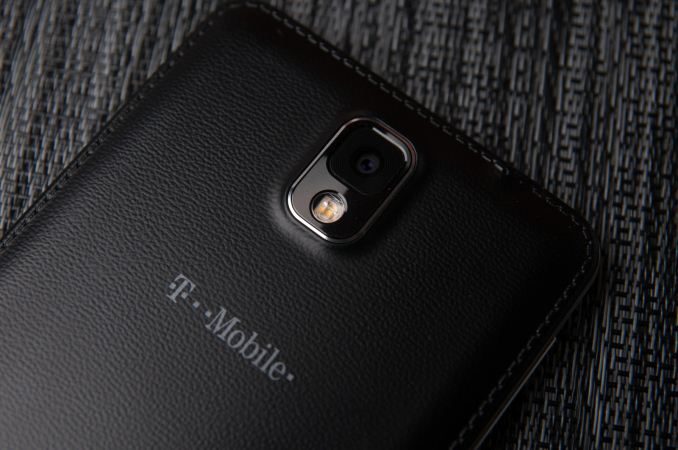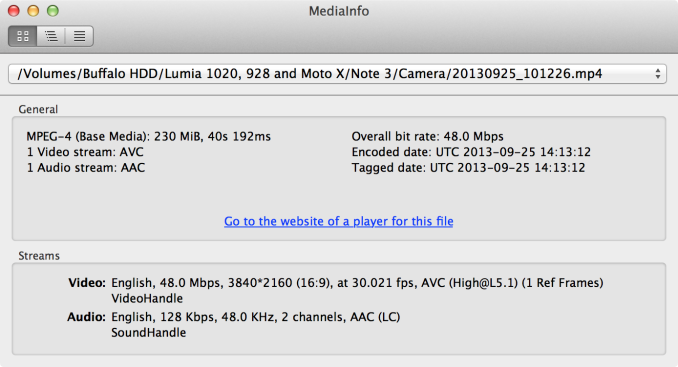Samsung Galaxy Note 3 Review
by Brian Klug on October 1, 2013 9:00 AM EST- Posted in
- Smartphones
- Samsung
- Mobile
- Android 4.3
- galaxy note 3
Camera
The cadence for camera on the Note platform has been pretty steady so far, it just inherits the camera module from the Galaxy S that came before it. In the case of the Note 3, that means the same module from Galaxy S 4, which is as far as I can tell what happened here. There’s an IMX135 sensor inside the Note 3, same as what shipped in GT-I9500, from Sony’s Exmor RS line. Specifically that means the Note 3 includes a 13 MP CMOS on the back with 1.12µm size pixels and a 1/3.06" optical format. Focal length changes slightly from 4.2 to 4.1 mm, but I’m not sure if this is just a rounding error, I suspect the same optical system is shared between the two, this works out to 31mm of focal length if you’re thinking 35mm equivalent numbers.
On the front is a 2 MP Samsung S5K6B2 CMOS with 1.34µm and 1/6" format. This is also shared with Galaxy S 4, which isn’t too surprising. So we have the same imaging on the back and the front as that flagship, with just different ISP in front of it with 8974.
Stills
For image quality we turn to the normal set of tests which I seem to always be adding to. Image quality bench locations taken at our usual set of locations, 3, 4, 5, 6, and 7 with the Note 3. In addition lights on and lights off in the lightbox, and the usual set of test targets.
Gallery: Smartphone Camera Bench
The Note 3 looks good outside and obviously reminds me exactly of the Galaxy S 4 when it comes to imaging performance. I never really had issues with SGS4 outside or in well lit scenarios, the Note 3 ends up being just about the same. I can’t say there’s really any surprises when it comes to still images out of the device, although the Note 3 absolutely struggles with white balance in the lightbox for some reason, which is odd considering Galaxy S 4 definitely didn’t have similar problems. Anyhow if you liked SGS4 imaging performance, Note 3 is definitely the same, it doesn’t really change the formula in low light however against the competition that now has OIS and bigger pixels, but I won’t belabor that point again.
Video
On the video side of the Note 3 we have an interesting new addition, 4k30 (or UHD) video record support, alongside both 1080p60 and 720p120. Higher framerate video has been an increasingly common thing lately, and the Note 3 supports this with the new video encode and decode capabilities of the 8974 SoC (Exynos 5420 doesn’t get any UHD video record features).
In the video recording UI you can select between the above video resolutions, at a framerate of 30 FPS. To get to 1080p60 you have to go under a different menu and select smooth motion, and 720p120 is under slow motion.
4k30 video gets recorded at 48 Mbps H.264 high profile with 1 reference frame, which will eat up space quickly but obviously blows things away with that much resolution, and 8974 doesn’t drop frames either. The 1080p60 video comes in at 28 Mbps H.264 high profile and also doesn’t seem to have any dropped frames. Audio in both cases is 128 kbps 48 kHz stereo AAC.
I uploaded two UHD samples to YouTube since it’s already 4K aware, if you select original quality from the switcher drop down. I don’t have a 4K display to view these on, but oversampled on the high resolution panels I do have it looks amazing. The 1080p60 content also looks great, although you’ll have to grab that one and view it on your own since YouTube (and really nowhere online I’m aware of) will show you 60p video at native framerate. I shot UHDp30 and 1080p30 videos in Times Square in NYC which you can grab, and UHDp30 and 1080p60 videos at the bench location which you can also grab if you want to look at that buttery smooth 60 FPS video.
I’m really impressed with video quality coming out of the Note 3, obviously having smartphones coming with UHD onboard is a big treat, and we now have smartphones beating other bigger standalone cameras to that punch.






















































302 Comments
View All Comments
Nathillien - Tuesday, October 1, 2013 - link
You whine too much LOL (as many others posting here).vFunct - Tuesday, October 1, 2013 - link
I agree that it's cheating.The results don't represent real-world use. Benchmarks are supposed to represent real-world use.
Geekbench actually runs real programs, for example.
Che - Tuesday, October 1, 2013 - link
Since when do canned benchmarks really represent real world use?I don't have a dog in this fight, but benchmarks are very controlled, tightly scripted, and only give you details on the one thing they are measuring. The only way to define real world performance is by..... Using said device in the real world for a period of time.
I care more for his comments on the actual use of the phone, this will tell you more than any benchmark.
doobydoo - Saturday, October 19, 2013 - link
They are meant to be a way of measuring the relative performance that you'll get with real world use.Whatever the actual benchmark, provided some element of that benchmark is similar to something you'll do on the device, the relative performance of different phones should give you a reasonable indication how they will relatively perform in real world use.
The problem is when companies specifically enable 'benchmark boosters' to artificially boost the phone above what is normally possible for real world use, and thus the relative scores of the benchmark which were previously useful are not.
darwinosx - Tuesday, October 8, 2013 - link
So you are a kid that owns a Samsung phone. Yes, it really is that obvious.Spunjji - Tuesday, October 8, 2013 - link
Handbag.runner50783 - Tuesday, October 1, 2013 - link
Why is this cheating?, is not that they are swapping CPUs or anything, the SoC is still running under specification, so, get over it.What this make is benchmarks irrelevant, because Manufactures can tweak their kernels to just get better scores that do not reflect daily use.
Chillin1248 - Tuesday, October 1, 2013 - link
No, it is not running under the specification that the consumer will get.They raise the thermal headroom, lock the speed to 2.3 ghz (which would normally kill battery time and cause heat issues). Now if Anand would test the battery life while looping the benchmark tests, then it would be fine as the discrepancy would show up. However, he uses a completely different metric to measure battery life.
Thus, Samsung is able to artificially inflate only their benchmark scores (the only time the "boost" runs is during specific benchmark programs) while hiding said power usage to get those scores.
vFunct - Tuesday, October 1, 2013 - link
It's cheating because the resuts can't be reproduced in the real world for real users.Geekbench uses real-world tests, and they need to represent real use.
Samsung artificially raises the speed of Geekbench so that, for example it's BZip2 compress speeds can't be reproduced when I run BZip2 compress.
Samsung doesn't allow me to run BZip2 as fast as they run it in benchmarks. Samsung gives the benchmarks a cheat to make them run faster than what the regular user would see.
bji - Wednesday, October 2, 2013 - link
You know, you'd think benchmark authors would figure this stuff out and provide a tool to be used with their benchmark to obfuscate the program so that it can't be recognized by cheats like this. Whatever values the cheaters are keying off of when analyzing the program, just make those things totally alterable by the installation tool. If the benchmark program ends up with a randomized name, it is still usable for benchmarking purposes and the cheaters cannot tell its the benchmark they are trying to cheat on.Seriously why do I have to be the one to always think of all of the obvious solutions to these problems!??! Same thing happens at work! lol